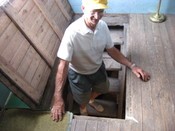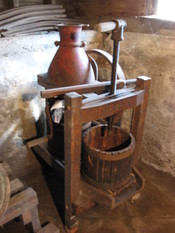By Finger Lakes Correspondent Jason Feulner

Wine is found in many interesting places, and sometimes it says more than we expect.
Every 4th of July, my wife’s extended family on her father’s side has a large picnic at The Farm, referred to as such because it is the origin of her family’s history in Central New York. Just after the turn-of-the-century, the Sgroi family migrated to the Canastota, New York farm and took up a living as onion farmers, owing their trade to the muck lands that abound in the area.
The family’s language was Italian, and the first generation offspring learned English, went to American schools, and then headed out to a variety of careers and experiences. My wife’s grandmother, now 94, raised a family in nearby Oneida. Her youngest brother, 81-year-old Sam, never left the farm and continues the family tradition.
Despite the fact that the onion trade has since moved to regions with a year-round growing climate, Uncle Sam still keeps a hefty garden, the bounty of which he shares with family members or donates. This year, I noticed a row of grape vines which I’ve overlooked in the past. I found Uncle Sam helping some young children pick vegetables and asked him about the vines.
"I grow some Concord and Niagara," he told me. "The best is Catawba, though. Those grapes are amazing. I’ve made some great wine with those grapes."
I was excited to hear this, knowing that Catawba is practically one of the only American grapes, or Vitis labrusca, that has been known to produce accomplished wines. In the 19th-Century, producers in the Ohio Valley and Keuka Lake in the Finger Lakes created sparkling wine from Catawba that impressed European critics.

Uncle Sam agreed to show me his wine cellar and antique wine press, of which I took pictures. He told me funny stories about bottling certain years too early, only to have the fermentation blow up the bottles in the cellar, creating quite a mess. When I asked Uncle Sam where he learned how to make wine, he told me that his parents and their relatives brought such knowledge from Italy, and that many farmers from Europe who came to this country made their own wine.
I was sad to hear that Uncle Sam hasn’t made wine in quite a few years-I would have loved to have tasted some Catawba several decades ago when he was more of an active winemaker. Today, most of his grapes end up in jam or on the table.
Americans are often inclined to believe that we have a dearth of historical traditions. Unfortunately, we let far too many stories and anecdotes pass away with the older generations.
The winemaking that took place on a small scale on this tiny Canastota farm is not directly linked to any current producers or trends, but it is just one part of what is a largely forgotten past of early American winemaking. European immigrants brought with them an appreciation for wine and willingness to experiment with native grapes. In some way, the entrepreneurs and winemakers who are active today have benefitted from these activities.
Those who love local wine speak of a sense of place. How more poetically can we explain this than envisioning an immigrant farmer, on an isolated farm miles from anywhere, creating his newest vintage in a small wooden press? He was making wine for family and friends, from his own labor, and did not even think to compare it to the latest ratings or fads. I’m sure it was delicious.
Bottoms up! I hope all of you had a great 4th of July.
